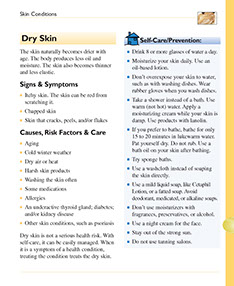CONDITIONS
SYMPTOM CHECKER
Male
Female
Child
Arm, Hand & Shoulder Concerns
Legs & Feet Concerns
Dental & Mouth Concerns
Ear & Nose
Eye Conditions
Head Conditions
Arm, Hand & Shoulder Concerns
Legs & Feet Concerns
Front
Back
Arm, Hand & Shoulder Concerns
Dental & Mouth Concerns
Ear & Nose
Eye Conditions
Head Conditions
Arm, Hand & Shoulder Concerns
Dental & Mouth Concerns
Ear & Nose
Eye Conditions
Head Conditions
Front
Back
Arm, Hand & Shoulder Concerns
Neck Links
Head & Neck Concerns
Arm, Hand & Shoulder Concerns
Neck Links
Head & Neck Concerns
Front
Back
Online Clinic
Wise Healthcare
Aging Dry Skin
The skin naturally becomes drier with age. The body produces less oil and moisture. The skin also becomes thinner and less elastic.
Signs & Symptoms
• Itchy skin. The skin can be red from scratching it.
• Chapped skin
• Skin that cracks, peels, and/or flakes
Causes, Risk Factors & Care
• Aging
• Cold winter weather
• Dry air or heat
• Harsh skin products
• Washing the skin often
• Some medications
• Allergies
• An underactive thyroid gland; diabetes; and/or kidney disease
• Other skin conditions, such as psoriasis
Dry skin is not a serious health risk. With self-care, it can be easily managed. When it is a symptom of a health condition, treating the condition treats the dry skin.
Self-Care / Prevention
• Drink 8 or more glasses of water a day.
• Moisturize your skin daily. Use an oil-based lotion.
• Don’t overexpose your skin to water, such as with washing dishes. Wear rubber gloves when you wash dishes.
• Take a shower instead of a bath. Use warm (not hot) water. Apply a moisturizing cream while your skin is damp. Use products with lanolin.
• If you prefer to bathe, bathe for only 15 to 20 minutes in lukewarm water. Pat yourself dry. Do not rub. Use a bath oil on your skin after bathing.
• Try sponge baths.
• Use a washcloth instead of soaping the skin directly.
• Use a mild liquid soap, like Cetaphil Lotion, or a fatted soap. Avoid deodorant, medicated, or alkaline soaps.
• Don’t use moisturizers with fragrances, preservatives, or alcohol.
• Use a night cream for the face.
• Stay out of the strong sun.
• Do not use tanning salons.
• Use a sunblock with a sun protection factor (SPF) of 15 or higher.
• If you get symptoms of dry skin:
– Don’t scratch or rub the skin.
– Apply oil-based moisturizers often.
– Lessen exposure of the affected area to water.
When to Seek Medical Care
Contact Doctor When:
• You have any of these problems with dry skin:
– Deep cracks on the hands or feet
– Tight, shiny, or hardened skin
– Itchy skin areas that are raised, have red borders, and are covered with large white or silver-white scales
• You have signs of an infection (fever; increased redness, swelling, pain, or tenderness; pus; blisters; red streaks from the affected area).
• You have diabetes and the dry skin is troublesome.
• You have symptoms of low thyroid.
• You have dry skin without a rash and you itch all over.
• Severe itching keeps you from sleeping.
• Self-care brings no relief.
This website is not meant to substitute for expert medical advice or treatment. Follow your doctor’s or health care provider’s advice if it differs from what is given in this guide.
The American Institute for Preventive Medicine (AIPM) is not responsible for the availability or content of external sites, nor does AIPM endorse them. Also, it is the responsibility of the user to examine the copyright and licensing restrictions of external pages and to secure all necessary permission.
The content on this website is proprietary. You may not modify, copy, reproduce, republish, upload, post, transmit, or distribute, in any manner, the material on the website without the written permission of AIPM.
2021 © American Institute for Preventive Medicine - All Rights Reserved. Disclaimer | www.HealthyLife.com
















































